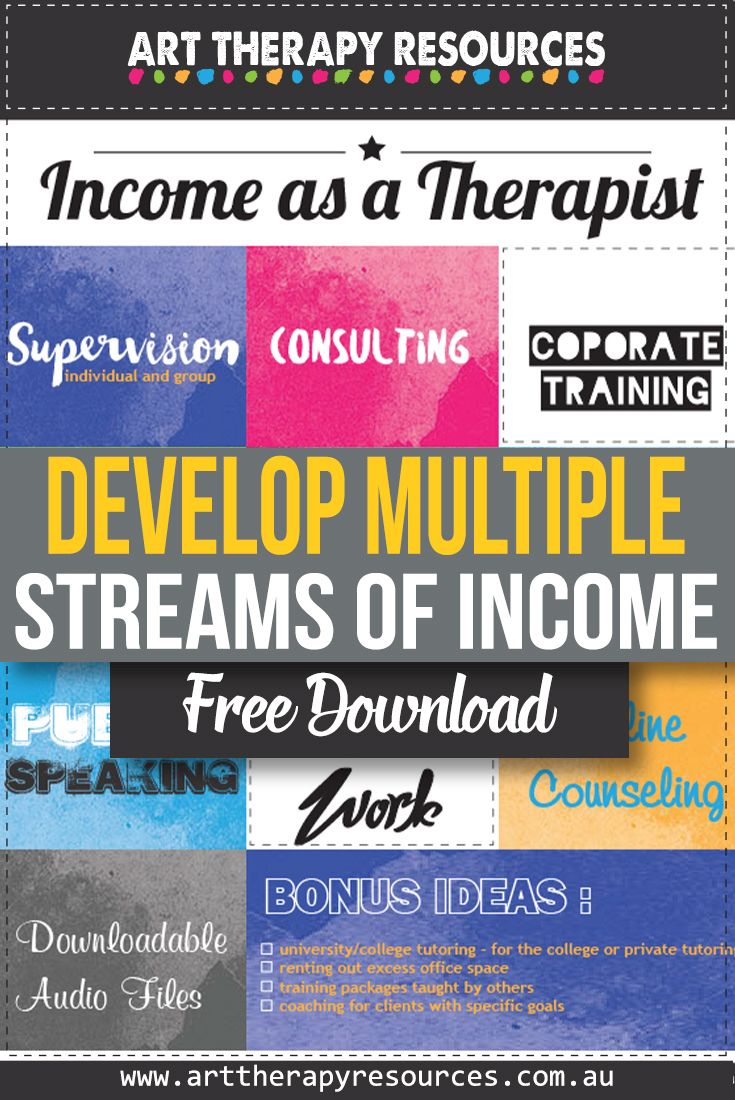THIS POST INCLUDES:
1. Types of income
2. Identify your income
3. Develop streams of income
4. Free Download Income as a Therapist
TYPES OF INCOME
- Active earned income
- Passive income
- Investment income
Active and passive income relate to activities you can initiate using your professional services. Investment income refers to using the income of your professional services to invest in financial instruments that earn additional income. Investment income could be viewed as passive income, however, the distinction is usually made because investment income is usually derived based on no effort, input, or control factors of your own. Your investment income is usually determined based on external factors such as industry interest rates.
In this article, we will exclude investment income from the discussion as this is typically an area that should be discussed with your accountant who can offer more specific advice that covers any potential tax implications.
Active income refers to the income that is derived based on your efforts. Active income is typically derived through client fees where your time is compensated with payment.
Passive income refers to income that is earned without your ongoing personal efforts. Note the distinction is made to identify ‘ongoing’ personal efforts. Passive income doesn’t imply you don’t need to put in actual effort to earn income. It means you can create a product once and then sell it multiple times. Your efforts would then go into marketing your product to ensure it keeps selling.
Some people may think that passive income refers to any other income you earn that isn’t one-to-one client work, however, this is not the case. Some work outside of client work is still considered active income earning. For example, workshops that are delivered to multiple participants may mean you can earn more income by providing a service to many people at the same time, however, it is still necessary for your time and effort to be used for each workshop that you provide.
IDENTIFY YOUR INCOME
Some potential streams of income include:
- Supervision – supervision can be offered to individuals or as group supervision.
- Consulting – businesses, corporations, government departments, and community organisations regularly seek external advice when developing internal or community policy.
- Training – similar to consulting you can develop training packages that can be developed for business or government interests. Community organisations may also benefit from training from a mental health professional on specific topics. Some large corporations have annual training budgets that they look to utilise each year. You can also train other therapists who then create their programs (classed as train the trainer).
- Ecourses – ecourses are conducted online with less direct contact. Ecourses allow you the ability to upscale your course delivery to potentially thousands of people compared to the limited number of people that are taught at in-person events.
- Ebooks – ebooks can be sold through established marketplaces such as Amazon or your website.
- Writing – write for other publications or media outlets either online or inprint.
- Public speaking – earn income by speaking at conferences, community organisations, government departments, and corporate events.
- Contract work – offer your services to other practices that are looking for contract workers to cover the absence of one of their therapists for a specific period. This could include maternity coverage or carer’s leave.
- Online counseling – in addition to in-person therapy, you can add online counseling services that are becoming increasingly popular.
- Audio files – audio files can be useful for clients who like to have access to therapeutic tools at any time. Examples of audio files that can be sold include meditations and relaxation focused topics.
- Tutoring – working at a university or college could include lecturing, practical workshops, or exam marking. You could also provide private tutoring directly to students.
- Coaching – clients may be looking for motivational mentoring to achieve a specific goal. This could include starting their own new business or embarking on a change in their life. Seek advice on whether you can provide coaching services based on your specific therapist licensure.
- Renting out office space – if you have space in your office, you could rent out areas to other therapists. This may suit some therapists who are only looking for part time office access.
As you identify the income streams that you can potentially develop as part of your practice, learn to recognise your strengths and personal interests so that you can choose the most relevant opportunities available to you. You may have stronger writing skills than public speaking skills. You may also prefer working with community groups instead of corporate groups.
Developing your therapy practice requires an ability to apply insight in identifying your skills and interests that you can use to derive your therapist income.
DEVELOP STREAMS OF INCOME
If you are running a private practice, then your time is limited and you should focus on developing 1-2 different income streams to begin with.
The more people you have working in your business, the more you can diversify your revenue streams as the human resources can be divided amongst the various activities within your therapy practice. You may have therapists who focus solely on client work, while other therapists connect with community and corporate organisations to develop revenue on a larger scale.
You can also hire non-therapist employees who can produce and market physical products that suit your therapy practice.
Even if your practice isn’t large enough to hire staff, you can collaborate with other therapists or hire someone short term to achieve a specific task that will contribute to developing additional revenue streams.
Before developing additional streams of income, it’s useful to understand what your business goals are. Questions you can ask yourself to help develop your goals include:
- How many clients can you realistically work with each week?
- Do you wish to develop any products or services outside of client session work?
- What type of clients do you want to work with?
- Do you want to be a sole practitioner or work with others – could be hired staff or peers under a partnership
- If you are running a practice now, how effective do you think you are operating currently on the above goals?
When developing multiple income streams, you should remain flexible and adaptable. If you develop a strategy and realise along the way that some of the tasks are difficult and causing more problems and stress in your life, then you should be flexible and either eliminate the problem or find an alternative way of reducing the impact.
Whatever strategy you develop for your therapy practice should stay aligned with your ethics in running your therapy practice. If something makes sense financially, yet doesn’t feel right for your business ethically, then you find an alternative strategy to achieve the same result.
The strategy that you create is an initial estimate of what you plan to do at that time. These estimates are guidelines for you to work towards to achieve your overall income goals, however, they can be changed when required.
When you are ready to move forward with developing your streams of income, we have many resources below that can help you achieve your goal:
- 30 Day Launch to Your First Online Course
- 30 Days to Create Your Therapy Ebook
- How Do I Create an Ecourse for my Therapy Practice
- How to Create Physical Products for your Art Therapy Practice
- How To Organise an Art Therapy Group
We also have some resources in the store that provide specific guidance on creating additional income streams, including the Course Planner Package:
This course planner package provides a roadmap on how to get your course completed from choosing your course topic to creating course content and then launching your course with a strong marketing strategy in place.
The package includes 4 major sections:
- Course Admin – the course admin section will help you to establish the administrative foundation that will help support your course creation process. Setting up the basic admin structure you need will help boost your productivity and efficiency in getting your course completed.
- Course Design – this section will help provide you with the core decisions that have to be made about your course topic, format, and delivery method. Included are the essential components of creating your course modules.
- Marketing – once your course is completed, you will need to implement an effective strategy to market your course. This section contains specific details about the marketing assets you will need and the sales channels you should market.
- Worksheets – here’s where you get to work! These worksheets provide all you need to complete your course fast!
You can find a detailed breakdown of what’s included in the Course Planner Package in the store using this link: Course Planner Package
FURTHER READING
FREE DOWNLOAD: Art Therapy Exercise

BUILD YOUR ART THERAPY REFERENCE MATERIALS:
Pin this image to your Pinterest board.

SHARE KNOWLEDGE & PASS IT ON:
If you’ve enjoyed this post, please share it on Facebook, Twitter, Pinterest. Thank you!
